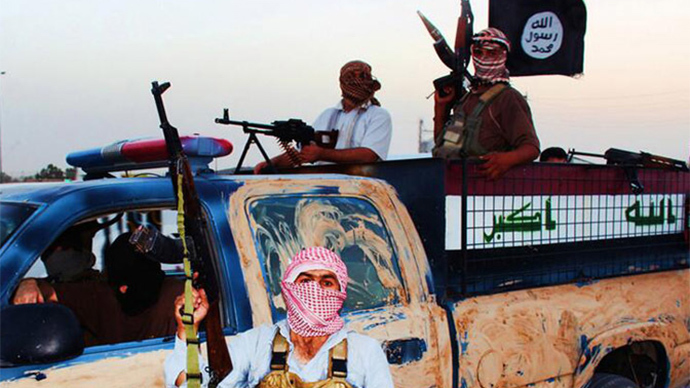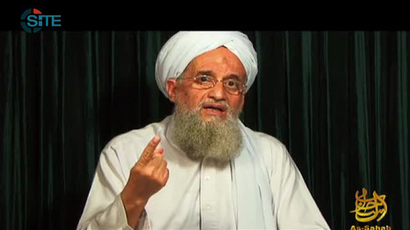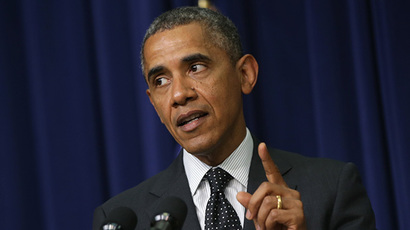RT’s special report on the Islamic State: Newly formed, newly armed, newly funded

The Islamic State (formerly ISIS) seems to have swept into Iraq and Syria out of nowhere, leaving death, destruction and fear in its wake. RT takes an in-depth look at where it came from, its financing and weaponry, and whether US involvement is needed.
“In the Middle East, one form of tyranny often replaces another,” Sen. Rand Paul (R-Ky.) said at the Conservative Political Action Conference on Friday. “When secular despots are overthrown, chaos ensues and radical Islam grows stronger.”
It was after the US invasion of Iraq in 2003 to overthrow Saddam Hussein, the country’s long-time dictator, that the story of the Islamic State (also known as ISIS or ISIL) began.
Islamic State’s roots
The US invaded Iraq in 2003 and removed Hussein from power. The war destroyed the country’s infrastructure, installed a government that was not responsive to its people ‒ especially minorities ‒ and jailed thousands of men America deemed to be radicals, said RT’s Ben Swann. Then US troops left the destabilized, weak country with a destroyed infrastructure and huge amounts of surplus American military gear.
ISIS formed as a small insurgent group in 2006 that tried to create problems for the US military, but it had no money or ability to recruit. Largely unsuccessful in Iraq, the group turned to neighboring Syria in 2009. When civil war erupted there in 2011, ISIS was able to gain a foothold.
By 2013, the US and other countries began arming rebel groups battling Syrian President Bashar al-Assad. And that’s when things began falling apart. Less than a year later, those coalition-provided weapons were in the hands of ISIS fighters as rebels began deserting the more moderate groups for ISIS. By June 2014, ISIS began crossing back into Iraq, exploding into the international consciousness due to their ruthlessness and threats of jihad.
Financing Terror
The Islamic States’ wealth comes from its seizing of oil fields in Iraq and Syria and selling the natural resource on the black market, Marin Katusa, the chief energy investment strategist at Casey Research, told RT. The latest reports show that the group is earning over $1 million a day from producing and smuggling oil. While the group can export 400,00 barrels of oil a day from the fields it controls, that’s a mere drop in the proverbial bucket compared to the legal oil market, which produces 92 million barrels a day.
The US and its coalition partners have responded by bombing those fields controlled by the Islamic State. But what happens when ISIS is defeated, Swann asked. “That’s just a horrible policy,” Katusa said.
“You can shut down these wells, and… let’s just say you scorch them and break down the pipeline, you know, depending on how bad you’ve demolished the infrastructure, you can get it back going in 90 to 120 days, depending,” he added. How long it takes depends on where the destruction occurs along the production and transportation process, and a port system could take up to six months to get back online, he said.
The airstrikes have lowered the Islamic State’s ability to make money off its oil sales, most of which are made to people and business in the region, RT’s Ameera David reported. The rest is smuggled into neighboring countries, making it difficult to track and know who is purchasing the resource from the terror group.
"We buy an oil tanker carrying around 26 to 28 tonnes [of oil] for $4,200. We sell it in Jordan for $15,000. Each smuggler takes around eight tankers a week," Sami Khalaf, an oil smuggler and former Iraqi intelligence officer under Saddam Hussein, told the Guardian. Khalaf, who lives in Jordan's capital, Amman, said smugglers typically paid corrupt border officials $650 to pass through each checkpoint.
IS vs. the Iraqi Army
When ISIS marched back to Iraq from Syria, they found that the Iraqi army, without the American troops who trained them serving as backup, was no challenge for them. They faced minimal resistance as they gobbled up large swathes of land and American-made materiel deserted by Iraqi troops on the retreat.
How could an entire army, funded at a cost of $25 billion to US taxpayers, simply fold to a relatively unknown group of Islamic militants, Swann asked. Was the Iraqi military set up to fail from the start?
When the US disbanded Hussein’s army in 2003, it rid the force of all its generals and experienced battlefield commanders who had fought in the Iran-Iraq War and the two Gulf Wars. Thus there was no established hierarchy to take control of security when US troops left the country.
Not only that, former Iraqi Prime Minister Nouri al-Maliki was dogged by accusations of corruption and favoritism, alienating Sunni Muslims in favor of those from his own Shi’a sect.
“The Maliki government has spent a lot of time over the past five years alienating the Sunnis… and that’s not how you create an effective security force that has high morale,” Austin Long, a military advisor in Iraq in 2007-2008, told Al Jazeera in 2014. “It was a little bit of a rotten edifice to begin with.”
Bringing the two issues together, a headcount taken during an Iraq military payroll period last January revealed 50,000 “ghost soldiers” spread among four units who don’t work - or don’t even exist - but are paid, Prime Minister Haidar al-Abadi told the parliament.
“There are two kinds of ‘fadhaiyin,’” an Iraqi officer told AFP, using a term for fictitious soldiers crowding the payroll, which literally translates as “space men.”
“The first kind: each officer is allowed, for example, five guards. He’ll keep two, send three home and pocket their salary or an agreed percentage,” he said. “Then the second and bigger group is at the brigade level. A brigade commander usually has 30, 40 or more soldiers who stay at home or don’t exist.”
The other ghost soldiers are those who were killed or deserted, but their names were not reported to the military.
These factors allowed ISIS to sweep into the country, taking over Iraq’s biggest dam, stealing millions of dollars and seizing tons of US-made materiel, including rocket launchers, guns, tanks and armored vehicles. (When the US pulled out, it left behind 4 million pieces of equipment valued at $580 million. The US military said it saved $1 billion in shipping costs by leaving the weapons and vehicles in Iraq.)
“Today it’s been reported that the Iraqi army is, at best, half the size that it was when the US pulled out of the country,” RT’s Manuel Rapalo said, “reigniting the debate in Washington over whether or not US forces will once again step in.”
What Should the US Do About ISIS?
The leaders that the US deposed, such as Saddam Hussein and Moammar Ghadafi, came to power because they were the most brutal of their opponents, but they created functioning ‒ though repressed ‒ societies, Swann said. Without them, the power vacuum created leaves opportunities for new dictators or terrorist groups to seize control.
Jason Stapleton, a US special operations Marine veteran, believes that, while the Islamic State must be stopped and must be opposed, it is not really a threat to the United States.
“We created the mess,” Stapleton told RT. “But the problem is, if you look at US policy and what we’ve done so far in our nation-building campaign to first oust Saddam and then later Egypt (Mubarak) and then later Libya and Syria, we see that in every single case what we’ve done is create massive power vacuums, and it ‒ as you’ve correctly reported on over the course of your piece here ‒ what you’ve really created is the necessity of a US military in order to provide stability because there is no solid, stable foundation there.”
“And it doesn’t matter how long you’re there,” he continued. “We were 10 years in Iraq. It doesn’t matter how long you’re there. As soon as you pull out, as soon as you pull back, unless you’re going to take Iraq as a US province, as soon as you pull out, you’re going to see these militants come back in to try and secure power.”
Unlike previous times when winning a war meant taking control of a territory and governing it, hawks in the US seem to be advocating for constant warfare because the country is not leaving a functioning government behind it when Americans tire of the conflict and call for troops to be withdrawn.
“The problem is, they’re terrible at it,” Stapleton said. “If Iraq wasn’t a big enough education for us, then Egypt should have been, and if Egypt wasn’t, Libya should have been, and if Libya wasn’t, Syria should have been.”
Stapleton argues that the United States should let the countries figure things out for themselves, rather than constantly debate what military action or actions to take next to defeat the latest enemy in that country. Doing so, he said, would only continue the vicious cycle of preemption, nation-building, withdrawals and power vacuums for generations to come.














